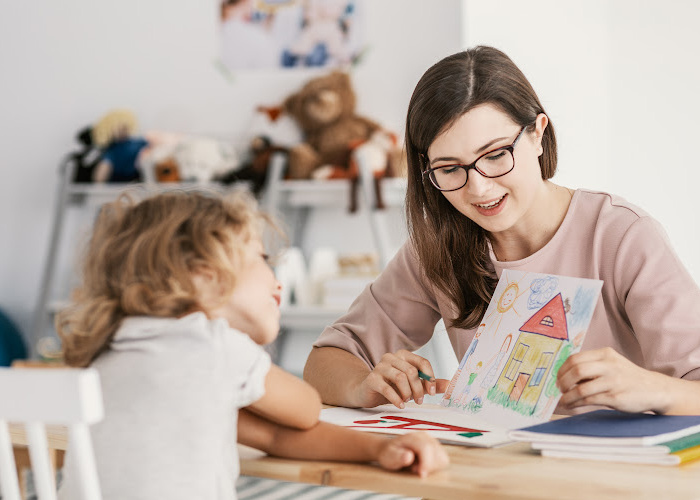It's crucial to know that students with autism and ADHD need special study strategies. Autism…

Ultimate Guide on How to Help an Autistic Child Communicate
As you navigate the path to enhance your child’s interaction with the world, understanding how to help an autistic child communicate becomes a pivotal part of your journey. Communication shapes our ability to express desires and engage with others, but for children on the autism spectrum, this can be quite challenging.
Whether your child has yet to find their voice or is mastering their language, there’s hope and help. With the right autism communication strategies and the support of autism speech therapy, you can be instrumental in improving communication skills in autistic children.
Each child’s communicative abilities are unique, and recognizing where your child is at is the first step towards progress. Repetitive language, creative expressions, and atypical pronoun use might be part of your daily experiences.
But fear not, as these are all signs of your child attempting to connect. By adopting tailored techniques to foster development, celebrating their attempts, and building on successes, you’re setting a foundation for meaningful interaction.
Throughout this guide, you’ll gain insights into a variety of methods endorsed by experts that can support and enrich your child’s attempts to communicate. Let’s embark on this journey together, fostering a more connected and expressive future for your little one.

Understanding Autism and Communication Challenges
Autism Spectrum Disorder (ASD) presents a unique set of communication challenges, which can deeply affect how autistic children experience and interact with the world around them. A common misconception is that all autistic children face the same hurdles, but in reality, you’ll find a wide spectrum of communication abilities among them. While some develop typical speech patterns, others might significantly struggle with spoken language and could express themselves through alternative means that might seem perplexing at first glance.
Developing effective communication techniques for autistic children is crucial, not just for basic needs, but also for nurturing their emotional and social well-being. Observing and responding to your child’s attempts to communicate – be it through words, gestures, or even behaviors that are sometimes misinterpreted as mere tantrums – can enhance their ability to engage with others.
Among the most supportive approaches is engaging with a child’s interests, which can be a key doorway to promoting social communication in autism. Whether it’s spinning wheels or stacking blocks, joining in their world and providing language related to their focused interest can make language learning relevant and immersive for them.
But how do you support the language development for a child on the autism spectrum? One effective method is to simplify language – use clear, concise sentences and avoid open-ended queries that can overwhelm them. You’ve likely found that visual aids forge a path to communication breakthroughs. Hence, utilizing images or icons to answer questions or convey messages will often lead to positive interactions and diminish the likelihood of misunderstandings.
An essential part of these speech and language interventions for autistic children is setting up clear boundaries and expectations. Structure in communication provides a child with a comforting predictability that eases the understanding of the ebb and flow of social exchanges. Furthermore, observing and noting in a behavior diary can inform tailor-made strategies that support their communication needs and preferences.
Remember, every effort you put into understanding and improving communication with autistic children not only enhances their language skills but also fortifies their trust and connection with you. By learning and applying these strategies, you are setting the foundation for a future where every child can share their thoughts and feelings meaningfully with the world.

How to Help an Autistic Child Communicate
Unlocking the door to communication for children with autism can often be achieved through simple yet profound strategies. With patience and understanding, you can play a significant role in enhancing your child’s ability to connect and express themselves. Let’s explore various methods that align with both verbal and nonverbal forms of interaction.
Engaging Through Play and Social Interaction
Immersing yourself in play with your child is more than just fun—it’s a foundational tool for teaching communication skills to autistic children. Through interactive games, singing, or even engaging in gentle roughhousing, you’re not only strengthening your bond but also promoting language skills in children with autism. Maintaining eye level can further foster this engagement, making communication feel more accessible and direct.
Mimicking to Encourage Vocalization
When you replicate the sounds and actions of your child, especially during positive play, it can be a powerful stimulus for vocalization. This mimicking game solidifies the idea of turn-taking and fosters communication development in autism, encouraging your child to imitate you and setting the stage for verbal interactions.
Focusing on Nonverbal Communication Skills
Often, enhancing communication abilities in children with autism begins without words. By emphasizing gestures, facial expressions, and eye contact, you’re laying the groundwork for later language skills. Acknowledging your child’s nonverbal cues like pointing or eye gaze confirms the value of their attempts at interaction and supports verbal and nonverbal communication in autism.
The Importance of Simplified Language and Pauses
Using clear and simple language can greatly aid in improving communication in autism. Start with one-word responses if your child is nonverbal, and gently increase complexity to spur language growth. Remember, pauses are critical—they give your child the precious time needed to process your words and formulate their own responses, supporting communication in autism.
Using Visual Supports and Assistive Technologies
For effective communication strategies for autistic children, visual aids like picture cards and assistive tech devices offer alternative pathways for expression. These tools can be particularly helpful for those who may face challenges in developing speech, providing them with means to convey needs and engage with their surroundings, thus improving communication skills in autism.
Conclusion
As you forge ahead with the important task of fostering communication in autism, it’s clear that the path is as diverse as the children themselves. Autistic children, each with their distinctive personality and abilities, may require different ways to enhance communication in autism. Your patience and dedication in teaching communication to autistic children can pave the way for them to express their unique perspectives and needs. With an open heart and informed strategies, you are empowering them to build meaningful connections with the world around them.
The process of promoting communication development in autism is ongoing and dynamic. By aligning strategies with your child’s needs and interests, you lay a foundation for growth. Structured play, imitation of positive behaviors, and attentiveness to nonverbal communication cues can be transformative. Moreover, by distilling language down to its essence and leveraging visual tools, you’re opening doors to understanding. Collaborating with experienced therapists further solidifies these efforts, providing a customized approach to facilitating communication in autism.
Ultimately, nurturing these communication skills is more than an educational goal—it’s about enriching lives. Autistic children have so much to contribute to our society, and by helping them find and use their unique voices, you’re fostering a more inclusive and understanding world. Your unwavering support and creative adaptations are not just enhancing communication; they’re unleashing the potential of every child to share their inner world, illuminating the tapestry of human experience.

FAQ
What are some key strategies to improve communication in autistic children?
Key strategies include engaging your child through play and social interaction, mimicking their sounds and actions to encourage vocalization, focusing on nonverbal communication cues such as gestures and eye contact, simplifying language and providing pauses for processing, and using visual supports and assistive technologies to aid understanding and expression.
How can I use play to support language development in my autistic child?
Play offers a natural and enjoyable way to foster language development. Engage in interactive play such as games, singing, or storytelling. Focus on your child’s interests and stay at eye level to enhance engagement. Imitate their actions and sounds positively to promote vocalization and turn-taking.
Should I always use verbal communication with my autistic child even if they are nonverbal?
It’s important to match the communication method to your child’s abilities and needs. Even if your child is nonverbal, speaking to them is still beneficial as it provides auditory input. However, you can also support their communication by responding to nonverbal cues, using gestures, and providing access to visual supports and assistive communication devices.
How can visual supports help an autistic child communicate?
Visual supports like picture cards, visual schedules, and communication boards can help children who are nonverbal or have difficulty with verbal communication to express their needs and wants clearly. These tools can reduce frustration by providing a straightforward way for children to make choices and communicate with others.
What should I do if I don’t understand my autistic child’s behavior?
If your child engages in behavior that you don’t understand, try to look for patterns or triggers that may explain their actions. Consult with autism professionals or therapists who can help you recognize and decode the behaviors. Keeping a behavior diary can also provide insights into what your child is attempting to communicate through their actions.
How can I teach communication skills to my autistic child?
Teaching communication skills involves consistency, patience, and understanding your child’s developmental level. Start with basic gestures and sounds, then gradually increase the complexity of language used. Incorporate your child’s interests into teaching moments and make communication a natural part of your daily interactions.
What role do speech therapists play in helping autistic children communicate?
Speech therapists specialize in assessing and treating communication disorders. They can provide personalized strategies and interventions to enhance speech and language development, help improve social communication skills, and offer tools and techniques suited to your child’s individual needs.
How can I encourage my autistic child to use language more effectively?
Encourage language use by engaging in activities your child enjoys, using repetition and reinforcing attempts at communication. Simplify your language to a level just above their current understanding, and offer choices to encourage decision-making and expression. Celebrate their successes to build confidence and motivation.
Are there any alternative communication methods for autistic children who may not develop speech?
Yes, there are various alternative communication methods including sign language, communication devices, and picture exchange systems. These alternatives provide children with options for expressing themselves and can be used alongside efforts to encourage verbal communication development.
How important is family involvement in the development of communication skills for autistic children?
Family involvement is crucial in the development of communication skills in autistic children. Consistent support and reinforcement at home can significantly enhance the effectiveness of strategies learned through therapy or school. Regular communication with professionals is also key to align approaches across different settings.



This Post Has 0 Comments